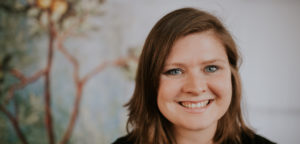
Getting to the Roots of the Cultural Crisis
February 25, 2020
 You could hear a pin drop. Their eyes were eager, tipping on the edge of cynicism, desperately hoping I had an answer. “Well?” my student pressed, “What’s the big deal? Love is love, right? I know a lot of homosexual couples who are more loving than heterosexual ones.”
You could hear a pin drop. Their eyes were eager, tipping on the edge of cynicism, desperately hoping I had an answer. “Well?” my student pressed, “What’s the big deal? Love is love, right? I know a lot of homosexual couples who are more loving than heterosexual ones.”
I knew I had to get to the root of the issue. But how? This was the question that rang in my brain over and over again as I faced my classroom. To use a scare tactic about STD statistics would be unhelpful, and ultimately insufficient. Appealing to positivism (“because the Church says so”) always leaves one with a hollow, unsatisfied feeling. Instead, we had to begin at the beginning. We had to see the “why” behind the “what”. We had to search out and peel the layers back, to expose the hidden principle where it all went wrong. Not sure where to start? Just start.
“Lots of things going on in that question”, I reply, “Let’s pick one. First of all, what do we think the Church is trying to protect in the prohibition of same-sex marriage? I mean positively trying to protect. Is she just trying to take rights away from people?” And so we begin. In the end we end up closer to the root of the issue, someplace like this: “Do our given bodies reveal something about one’s identity and purpose? Or is it merely a happy accident of biology whose meaning and use is left to my own choice?” This was my day-in-day-out for 8 years in the classroom before writing the 6th through 8th grade ROOTED: Theology of the Body curriculum. And I loved every minute of it.
It was then I knew the answers to these challenges had to be deeper, and start sooner. I knew it had to be the building of a beautiful vision, a positive story, the story of the great “yes” behind every “no”. In fact, that was what John  Paul II himself said in his Wednesday catechesis commonly called Theology of the Body: “In some sense, one can even say that all the reflections dealing with the ‘Redemption of the Body and the Sacramentality of Marriage’ seem to constitute an extensive commentary on the doctrine contained precisely in Humanae Vitae” (TOB 133:2). His theological anthropology was the positive context in which the prohibition of contraception made more sense. This is what got me excited about being part of the ROOTED project. Our team was truly unified in its purpose: to try and bring students to the root of the issues they face today, to be able to see “why” things are so, and above all to defend the beauty of the positive vision of male and female. No simplistic answers. No scare tactics, no positivism. We’d try and help give them new eyes with which to see the world, and feel the attraction of the truth of reality. For example, to see and to know — to really in-your-bones know — that “freedom” is not equivalent to “doing whatever I want” opens a world of ways for young people to respond to the challenges they will face in modern life.
Paul II himself said in his Wednesday catechesis commonly called Theology of the Body: “In some sense, one can even say that all the reflections dealing with the ‘Redemption of the Body and the Sacramentality of Marriage’ seem to constitute an extensive commentary on the doctrine contained precisely in Humanae Vitae” (TOB 133:2). His theological anthropology was the positive context in which the prohibition of contraception made more sense. This is what got me excited about being part of the ROOTED project. Our team was truly unified in its purpose: to try and bring students to the root of the issues they face today, to be able to see “why” things are so, and above all to defend the beauty of the positive vision of male and female. No simplistic answers. No scare tactics, no positivism. We’d try and help give them new eyes with which to see the world, and feel the attraction of the truth of reality. For example, to see and to know — to really in-your-bones know — that “freedom” is not equivalent to “doing whatever I want” opens a world of ways for young people to respond to the challenges they will face in modern life.
Simple, right? In a perfect world, maybe. As a writer, there were days of no inspiration, no creativity. There were days of discouragement after getting pages back from copyediting with large swaths slashed and questioned and refined. (You never know how vulnerable a thing it is to write until you open it to criticism). There were days where my brain was unclear and foggy. But I continued; we all continue, because we’ve been asked to. We light our candles, we open our hands to the Lord, and we set to work. And you realize it was never about you and your abilities in the first place.
 Those dazzling moments of inspiration do come, but often not on our timetable, and often in the most unlikely places. The 6th grade activity “Design Your own Album Cover” came as I was at a favorite coffee shop that serves up coffee and records (complete with record players in the back for listening, and displays scattered throughout). I was wracking my brain trying to think of an activity for the theme of Original Nakedness that would somehow communicate the meaning of symbol: the way in which the visible makes manifest the invisible. But I kept getting distracted by the albums that surrounded me, wondering why the artist chose those colors and images, what they were trying to express about their music with that choice, and I even tried to guess what genre of music it was based on the symbolic clues on the cover. “Lord, why I can’t I think of anything?!” I was frustrated. I had a deadline I was dangerously pushing. Then the penny dropped, “Ah, perfect. The album covers. Natural symbol. You’ve got this well in hand, Lord, don’t you?” Theology of the Body, and theology generally, is not some pie-in-the-sky area of study. God’s truth is all around us (Psalm 19:1). Even in hipster coffee shops. This is the kind of vision we’re trying to foster in the students (and teachers) using the ROOTED curriculum.
Those dazzling moments of inspiration do come, but often not on our timetable, and often in the most unlikely places. The 6th grade activity “Design Your own Album Cover” came as I was at a favorite coffee shop that serves up coffee and records (complete with record players in the back for listening, and displays scattered throughout). I was wracking my brain trying to think of an activity for the theme of Original Nakedness that would somehow communicate the meaning of symbol: the way in which the visible makes manifest the invisible. But I kept getting distracted by the albums that surrounded me, wondering why the artist chose those colors and images, what they were trying to express about their music with that choice, and I even tried to guess what genre of music it was based on the symbolic clues on the cover. “Lord, why I can’t I think of anything?!” I was frustrated. I had a deadline I was dangerously pushing. Then the penny dropped, “Ah, perfect. The album covers. Natural symbol. You’ve got this well in hand, Lord, don’t you?” Theology of the Body, and theology generally, is not some pie-in-the-sky area of study. God’s truth is all around us (Psalm 19:1). Even in hipster coffee shops. This is the kind of vision we’re trying to foster in the students (and teachers) using the ROOTED curriculum.
There is no magic bullet. There is no controlling another person’s relationship with truth, for the truth is a Person (John 14:6). With simplicity and fidelity, we do all we can to set up the right conditions for a lived encounter with the truth, and let Him do His work. He’s keeping us all through these difficult days in the Church and in the world. He’s got everything well in hand. Let’s say “yes” to doing our part, shall we?
 Written by Meghan Schofield,
Written by Meghan Schofield,
ROOTED: Theology of the Body Grades 6-8 Curriculum Author
Share